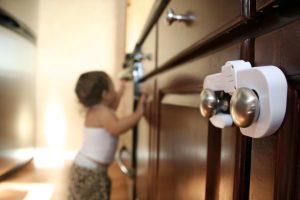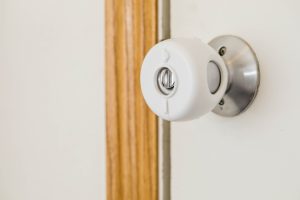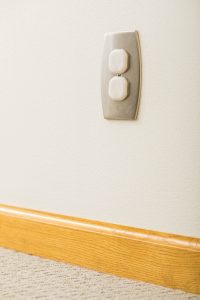By MARTHA SCANLON FISH
Like most things involving children, the practice of childproofing is constantly evolving. When I was growing up in the 1980s, my parents childproofed their wood stove by building a small wall out of cinder blocks. However, when my own daughter started crawling just a few years ago, I was able to find a heat-resistant gate that bolted to the wall and was specifically designed for the task.
The list of which areas in your home need to be childproofed seems to be growing as well. According to the Centers for Disease Control and Prevention, accidents involving unintentional injuries are one of the top causes of death in children under age 4, so while childproofing can seem like a daunting and time-consuming task at first, once completed it gives parents and caregivers peace of mind that children will be safe in and around their homes.
 Gates in hallways and between rooms are an ongoing standard, but these days they are available with varying widths and features like pet doors and easy-open latches that can be operated with one hand (allegedly, as those who are familiar know that all gates have their challenges). Larger gates are the perfect way to create designated play areas away from potential hazards, although they only work until the child is able to climb them! Gates are also handy to keep rambunctious pets away from crawling babies and young toddlers.
Gates in hallways and between rooms are an ongoing standard, but these days they are available with varying widths and features like pet doors and easy-open latches that can be operated with one hand (allegedly, as those who are familiar know that all gates have their challenges). Larger gates are the perfect way to create designated play areas away from potential hazards, although they only work until the child is able to climb them! Gates are also handy to keep rambunctious pets away from crawling babies and young toddlers.
Doors are another important area to child-proof, especially those leading to stairs, bathrooms and the outside. You can easily install locks for both doorknobs and door levers, as well as door stoppers that keep little hands from opening doors and prevent them from closing all the way.
Cabinet locks are helpful to keep curious toddlers from making a mess in the bathroom and kitchen, but they are especially important to keep them from areas where toxic cleaning supplies, chemicals and medications are kept. Single-use pods for laundry and dishwashers can be dangerous, as a baby or toddler can think that they are candy or food. (You can strategically leave one cabinet unlocked—I recommend Tupperware or pots and pans—to help toddlers safely entertain themselves while you cook or wash dishes!)
 Cabinet locks can also be used to secure the refrigerator. Or you can just keep things like alcohol and foods that are choking hazards out of reach on higher shelves and designate the lower shelves and drawers of the fridge for foods that children can safely help themselves to. Be sure to move magnets to the top section of the fridge as well, as these can be dangerous if swallowed.
Cabinet locks can also be used to secure the refrigerator. Or you can just keep things like alcohol and foods that are choking hazards out of reach on higher shelves and designate the lower shelves and drawers of the fridge for foods that children can safely help themselves to. Be sure to move magnets to the top section of the fridge as well, as these can be dangerous if swallowed.
Locks are also available for stove tops and oven doors.
Elsewhere in your home, televisions, dressers and bookcases should be secured to the wall for little ones who see them as climbing challenges. Radiators and hot pipes that could burn a child should be covered. Store any electrical devices away from water sources. Check the temperature on your water heater so that the water doesn’t get too hot, and don’t forget to cover electrical outlets and power strips that are accessible. Secure things like remotes and other devices that contain batteries, including button batteries that can be easily swallowed and cause severe injury.
 The importance of keeping cords for window blinds out of reach was unfortunately brought to light in 2016 when former NFL player Reno Mahe’s 3-year-old daughter died after she got tangled in a window blind cord. You can find a variety of safety clips and hooks to keep blind cords out of reach, and stores like KC’s Drapery and Blind Design in Falmouth offers cordless blind options that prevent children from becoming tangled.
The importance of keeping cords for window blinds out of reach was unfortunately brought to light in 2016 when former NFL player Reno Mahe’s 3-year-old daughter died after she got tangled in a window blind cord. You can find a variety of safety clips and hooks to keep blind cords out of reach, and stores like KC’s Drapery and Blind Design in Falmouth offers cordless blind options that prevent children from becoming tangled.
Outdoors, pools provide plenty of fun for small children but also plenty of hazards unless properly secure. Real Simple magazine recommends installing a fence that is five feet high around the perimeter of the pool: “Make sure that the gate to the pool has a lock that prevents children from entering alone but can be opened quickly by an adult in case of an emergency. And don’t let water accumulate on the top of the pool cover—that’s a drowning hazard.”
Also be sure to keep little ones away from grills and other dangers outside, such as sheds where tools and gasoline are stored. This is another great place to create a child-safe area for them to play and explore safely outdoors.
Childproofing products are available in most major online sites, and there are hardware stores locally where childproofing products can be found such as Eastman’s Hardware on Main Street in Falmouth and Aubuchon Hardware in East Falmouth, Pocasset and Sandwich.

